The Warehouse
Anna McCarthy and Joe Schell
The warehouse looms overhead, its crumbling towers high enough to block the afternoon sun as we slowly wind our bikes around the surrounding chain-linked fence. Windows boarded, paint peeling, metal bars crudely welded across any entrance or exit—we are not welcome here. Technically, the tuna canning factory decaying on the shores of San Francisco’s Islais Creek has been sitting empty ever since it was condemned after the 1989 earthquake. But the place has hardly been abandoned.
Joe and I are cautious adventurers. We become quiet when we realize that breaking and entering will be our only option in. But this will be our last opportunity to see what we are told is the largest living canvas for graffiti artists in San Francisco. A representative for the California Department of Transportation (Caltrans), which has owned the property since the mid-1930s, recently confirmed that the building is scheduled for demolition. So we press on to find an entrance.
For Caltrans, the demolition symbolizes a long-awaited victory. The building is an eyesore and a safety hazard. But for a small collection of unruly stakeholders—homeless, metal scrappers, junkies, graffiti artists, urban explorers, rats, pigeons—it means losing something they have reclaimed as their own. Joe wants to take photographs to document the final days of a building known best by San Francisco’s vagrants, and he let me come along.
The warehouse is located in Bayview Hunters Point, which is one of San Francisco’s only industrial neighborhoods. It’s also one of the poorest. On a plot of land under the overpass behind the warehouse, homeless have created a tent city whose only signs of life are the not-so-discrete comings and goings of its occupants, often dragging grocery carts full of cans and bottles behind them. Besides the occasional raucousness of these carts bumping down the street, the back roads here are mostly lifeless.
After scanning the street for witnesses to our intrusion, we wedge ourselves through a crack under the fence, wiggle through a small opening between a tangle of rebar on the side of the building, and drop into the belly of an enormous echoey chamber. We blink for a few moments, eyes adjusting to the low light.
It is quiet inside, the sound of nearby highway traffic muffled by layers of metal grating, boards, and aging cement. As we crunch through piles of debris on the ground, our footsteps ring through the building like an alarm—high ceilings as resonant as a symphony hall. Makeshift walls allow only slivers of light into the room. They cast eerie shadows over giant silos and mazes of rusting pipes that disappear into the ceiling—remnants of days when the warehouse was a bustling seafood plant.
But what we came to see is the art. It is everywhere we look: wide swaths of color, each piece more elaborate than the next. Even shattered remnants of windows are tinted into stained glass by spray paint. Some tags are taller than I am, with enormous curvy calligraphy, unreadable and elegant. It makes me think of hieroglyphics, or wall paintings—a language of pictures.
I don’t know much about graffiti. I know that it straddles the contested field between art and crime. I know it is a property owner’s nightmare and a radical’s dream. I know that while it can destroy one thing, it can create another at the same time. I know that it is not an art form that relies on permanence. But I get the sense, as we tip-toe jaw-dropped, through a labyrinth of high-ceilinged rooms, up four floors on narrow flights of stairs that smell like piss and chemicals, that for a long time now, the art covering the walls and the artists that made it have claimed more authority over the warehouse than its technical owners.
Rooms open up to let in more natural light with each ascending level. From the top floor, we peek our heads out of the broken windows and look out over a sea of car carcasses at a neighboring auto-body shop, the city’s skyline just a distant blip on the horizon. Down below, the slate gray waters of Islais Creek are a reminder of the building’s long history in the fish business.
The Washington Packing Corp. used the plant as a tuna canning factory until a couple cases of botulism shut the whole operation down around 1963. Another fish company called A. Paladini, Inc.—once the largest wholesale fish firm on the west coast—operated out of the warehouse until they too were forced to shut down in 1974 for financial reasons.
A neighboring business owner named Glenn Roiz explained to me later that between ’74 and ’89, a number of tenants came and went, including one who ended up murdering a former property manager on the premises. After the ‘89 quake, the state was forced to shut up the place completely. But their blockades did little to keep out the determined. Metal scrappers discovered a goldmine with the old equipment and have been pulling the place apart ever since.
Their work is evident as we wander around the warehouse. Still, some of the largest pieces of equipment would be impossible to cut out with a razor. Although the space is just a shell of its former self—deteriorating equipment painted over in reds, blues, and oranges—it is easy to imagine its heyday as the ground zero for fish processing in the Bay Area.
A pigeon flutters in the lofty ceilings. The wake-up call sends our hearts racing and our eyes upwards. Walls fifty feet up are covered in ink at heights that would require artists to brave the disintegrating rafters, can-in-hand, and perform acrobatics to paint without falling to their death. What little negative space left on the wall is scattered in piles on the floor: used hypodermic needles, condoms, empty boxes of cigarettes, candy wrappers, fast food containers, surgical gloves, and mountains upon mountains of empty spray paint cans. We trip over them at every turn.
After its days as a seafood factory, the walls of the warehouse acted as training grounds for serious graffiti artists. It is rumored that Jon See Lim—a popular local artist known as Tie One, who was shot and killed in 1998 when a tenant living at an apartment complex in the Tenderloin mistook him for an intruder—left his mark at the warehouse. Other artists leave his tags untouched in reverence, and many know the place as “Tie’s Warehouse.” For these artists, the demolition means losing an altar.
It would take hours to explore the place in its entirety—to see every piece of art on its walls. Exhaustion eventually wins out. It is tiring to be so anxious for so long. We take one last look around before shoving ourselves back through the portal we entered, and reemerge squinting into the outside world.
*
I revisit the warehouse three months later only to find that there is no warehouse. Instead, there is a wide swath of land covered in piles of dirt and dust and garbage and rubble. Caltrans had reclaimed their property the only way they could: by destroying it.
I roll towards the same chain-linked fence that Joe and I snuck through three months earlier, but there are no looming towers blocking the sky anymore. The street is full of light. I can see Islais Creek and the freeway behind it. On the grounds where the building stood, there are slabs of concrete stacked like cards and a few lone walls still standing just high enough to hold ceilings that would barely reach over my head. The few tags on those walls are the last reminders of the graffiti mecca that once stood in this place.
The actual area surrounded by the fence looks surprisingly small with no building on it. It makes me think about how much the way the warehouse was designed altered my experience of the space itself. The building took up an entire block, but it was the height and complexity of its interior—the labyrinthine corridors opening into amphitheaters the size of airplane hangars—that made it monstrous.
The graffiti artists will have to find a new mecca now. It’s likely they already have. Just as the homeless who once lived here have likely found another home, and the pigeons another roost.
Anna McCarthy is a journalist who has most recently been writing for weekly publications in and around the Bay Area. Journalism is her way of giving place a voice.
Joseph Schell is a photographer based in San Francisco. Check out www.jschellphotography.com for more information about his work.

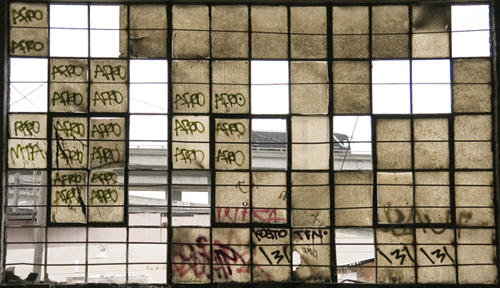
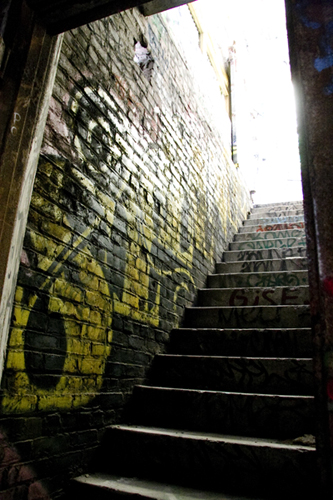
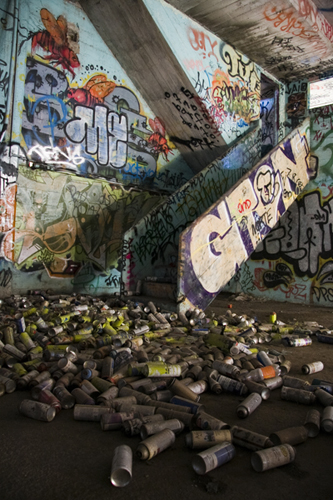
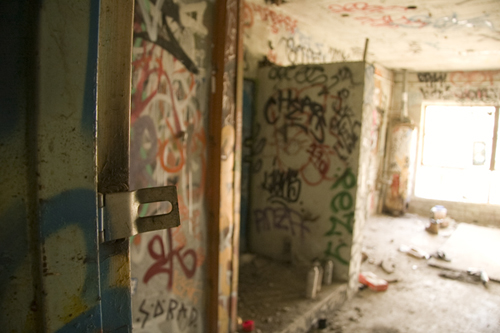
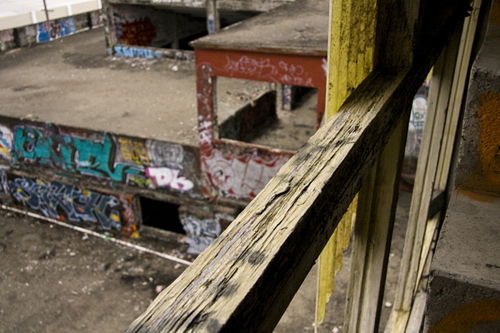
0 comments on “Photo Essay: McCarthy Schell”